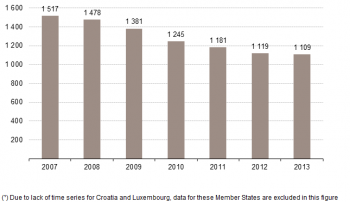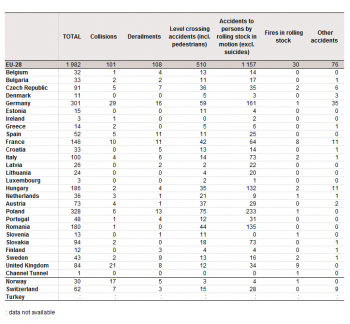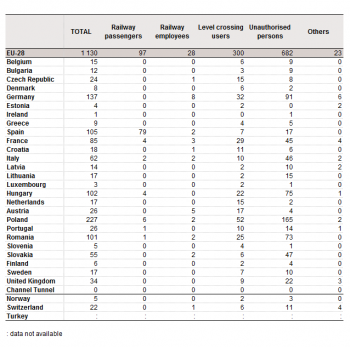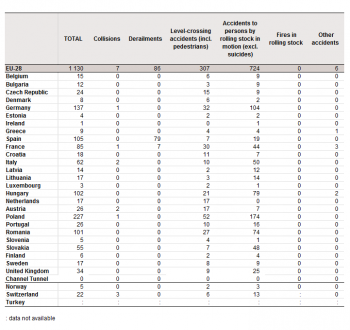- Data from January 2015. Most recent data: Further Eurostat information, Main tables and Database. Planned article update: January 2017.
In 2013, 1 982 significant railway accidents were registered in the 28 EU Member States, killing a total of 1 130 persons. Fatalities in the EU as a whole fell by 27% between 2007 and 2013. Railway suicides are reported separately: with 2 819 reported cases in 2013, they greatly outnumber the victims of accidents counted in railway safety statistics.






Main statistical findings
The European Railway Agency (ERA) has been collecting railway safety data based on the Common Safety Indicators (CSIs) since 2006. EU Member States have been applying the same standard definitions since 2010, so data are now fully standardized [1].
Accidents in 2013: 4% fewer than in 2012
Rail accidents fell between 2007 and 2013 (see Figure 2). In the EU as a whole, numbers were nearly halved. Accidents decreased by nearly 4% between 2012 and 2013, though not in all categories: collisions, derailments and fires in rolling stock increased somewhat. Accident figures are only reliable as of 2010, when common definitions were adopted. Belgium, Poland and Slovakia typically reported all accidents in the past, not just significant ones. Consequently, figures for several accident types have been lower since 2010.
The detailed 2013 figures (see Table 1) show that the largest single accident category in the EU as a whole is accidents to persons caused by rolling stock in motion, representing 58% of all accidents. Typically, these accidents involve trespassers hit by trains on railway tracks. The other major category is accidents at level crossings, including pedestrians, totalling 510 (26%). These two categories account for 84% of all significant accidents.
Poland, Germany and Hungary registered most accidents in absolute terms (see Table 1). In 2013, 17% of all accidents (328) recorded in the 28 EU Member States occurred in Poland, 15% (301) in Germany and 9% (186) in Hungary, compared with 3 accidents occurring in both Ireland and Luxembourg. The Channel Tunnel is listed separately. A single accident was reported: a fire in rolling stock, with no injuries or deaths.
Rail accident deaths: most involve trespassers
Figure 1 shows absolute numbers of persons killed in railway accidents. Total fatalities gradually declined from 1 517 in 2007 to 1 109 (excluding data for Croatia and Luxembourg) in 2013, a 27% fall.
The European Railway Agency estimates the fatality risk for rail passengers over the last three years at 0.13 deaths per 1 000 million passenger kilometres – close to the risk estimated for air passengers and lower than the estimation for bus/coach passengers in Europe (see).
Among the 28 EU Member States, unauthorised persons and level crossing users accounted for 87% of all rail accident fatalities.
The Santiago de Compostela accident represents a very large share of the fatalities in the 'derailments' category (Table 3), which shows fatalities broken down by accident type in 2013. There were no reported deaths from 'fires in rolling stock' anywhere in the EU. Most deaths resulted from accidents to persons by rolling stock in motion (724 deaths, 64% of the total) and level crossing accidents (307 deaths, 27% of the total).
Far more railway suicides than deaths & serious injuries resulting from railway accidents
Suicides on railway premises rose between 2010 and 2012 from 2 756 to 2 997, then decreased slightly in 2013 to 2 819. The number of suicides on rail premises is significant in all EU Member States. Germany accounted for nearly 30% of the 2013 total (834 suicides), followed by France (291), the United Kingdom (267) and the Netherlands (220).
Data sources and availability
The figures supplied here are selected from data reported to the European Railway Agency (http://era.europa.eu) with which Eurostat has an agreement on disseminating data through Eurobase.
Railway accident data are also collected through Annex H to the Regulation providing for statistical returns on railway traffic and transport (Regulation (EC) 91/2003). However, this data collection is to be phased out, as similar data are available through the ERA. Similar data can thus be found elsewhere in the Eurobase data tree, in the 'Railway transport' sub-domain under 'Railway transport - Accidents (rail_ac)'. The Agency's data are located in the horizontal multi-modal information (tran) under 'Transport safety (tran_sf)'.
Data from these two sources may occasionally differ as the ERA has its own compilation procedures and quality checks. Moreover, data are reported to the ERA by the national safety authorities; data reported to Eurostat under Regulation 91/2003 are reported by the National Statistical Offices. The latter might depend on data from the same national authorities, but not necessarily so.
Context
National rail networks have different technical specifications for infrastructure – gauge widths, electrification standards and safety and signalling systems – which make it more difficult and costly to run a train from one country to another. EU laws exist to overcome such differences. Creating an integrated European railway area thus requires better technical compatibility –'interoperability'– of infrastructure, rolling stock, signalling and other subsystems of the rail system. Procedures for authorising the use of rolling stock across the EU's rail network also need to be simplified.
The European Railway Agency helps promote interoperability and develop uniform technical standards, a process in which cooperation between EU countries and rail stakeholders is essential.
The European Railway Agency, based in Lille/Valenciennes, France, is helping to build an integrated European railway area by improving rail safety and interoperability. Set up in 2006, it develops shared technical specifications and approaches to safety, working closely with stakeholders from the rail sector and national authorities, the EU institutions and other interested parties. Featuring a dedicated safety unit, the Agency also monitors and reports on rail safety in the EU.
The Agency has collected rail safety data since 2006 on the basis of the Common Safety Indicators (CSIs), introduced by Annex I to the Railway Safety Directive (Directive 2004/49/EC). EU countries are legally obliged to submit these to the Agency. It publishes an Overview of safety-related CSIs once data are consolidated. The CSIs data are reported via the ERAIL system and are available the same way. The full set of CSI data is made available in the annually published Railway Safety Performance Report. Accident figures are reliable from 2010 onwards, following the strict application of standard definitions. Belgium, Poland and Slovakia typically reported all railway accidents in the past, instead of significant accidents only. This meant a lower count in several categories of accidents since 2010.
See also
- ERAs Common Safety Indicators
- ERAs report on Railway Safety Performance in the European Union 2014
- Glossary for transport statistics
Further Eurostat information
Database
- Transport, see:
- Multimodal data (tran)
- Transport safety (tran_sf)
- Rail transport safety (tran_sf_rail)
- Rail accidents by type of accident (ERA data) (tran_sf_railac)
- Rail accidents victims by type of accident (ERA data) (tran_sf_railvi)
- Rail accidents involving the transport of dangerous goods (ERA data) (tran_sf_raildg)
- Suicides involving railways (ERA data) (tran_sf_railsu)
- Rail transport safety (tran_sf_rail)
- Transport safety (tran_sf)
Data collected through Annex H of Regulation (EC) 91/2003:
- Transport, see:
- Railway transport (rail)
- Railway transport – Accidents (rail_ac)
- Annual number of victims by type of accident (rail_ac_catvict)
- Annual number of accidents by type of accident (rail_ac_catnmbr)
- Annual number of accidents involving the transport of dangerous goods (rail_ac_dnggood)
- Railway transport – Accidents (rail_ac)
Publications
Methodology / Metadata
Composition of EU aggregates
EU-28: European Union composed of 28 Member States: Belgium (BE), Bulgaria (BG), Czech Republic (CZ), Denmark (DK), Germany (DE), Estonia (EE), Ireland (IE), Greece (EL), Spain (ES), France (FR), Croatia (HR), Italy (IT), Cyprus (CY), Latvia (LV), Lithuania (LT), Luxembourg (LU), Hungary (HU), Malta (MT), the Netherlands (NL), Austria (AT), Poland (PL), Portugal (PT), Romania (RO), Slovenia (SI), Slovakia (SK), Finland (FI), Sweden (SE) and the United Kingdom (UK).
Cyprus, Malta and Iceland have no railways. Liechtenstein's railways, which are operated by ÖBB, are included in the Austrian data.
The tables include the Channel Tunnel as a separate entity. Data referring to it cannot be assigned to either France or the United Kingdom. EU aggregates always include Channel Tunnel figures.
External links
Notes
- ↑ Due to this standardisation and in order to reduce the burden of the Member States, Eurostat is planning to suppress their data collection on rail accidents, and only use the data from ERA in the future. However, until this has been implemented, two parallel data collections are existing with small differences in collection, coverage and definitions. The differences are described in the metadata files trans_sf_rail. Article on rail safety containing Eurostat data is available here
